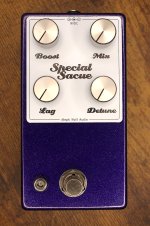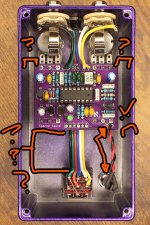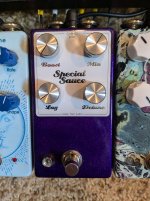Aleph Null
Well-known member
I built this one a while ago, but just noticed I hadn't posted about it yet. It's a short delay with envelop control pitch bending. This makes for unique chorus, doubling, slap back, and vibrato effects.

The enclosure is a Love My Switches limited run. The face plate is a one-sided aluminum PCB from JLCPCB.

The face plate made finishing a breeze and makes it easier to hide mis-drilled holes!

This PCB is from before I settled on using daughter boards for bypass switch and LED. It can still be wired neatly.

This circuit is tuned for short, bright delays ranging from 30–150ms or so. The short delay time meant I could use the first CMOS stage of the PT2399 as an input buffer instead of for filtering. A Mosfet at the output supplies 0—35dB of gain. It's voiced to cut frequencies below 140Hz or so. At the lowest setting, there is no frequency cut. The boost gets "brighter" as the gain is increased. This keeps things tight when boosting into an overdrive or dirty amp. The real trick here is using the voltage on pin 8 as an envelope follower (as discovered by DeadAstronaut). Instead of applying the pin 8 voltage directly to pin 6, I used it to control a 2N5089 set up as a voltage sink. This makes the pitch bending much more pronounced, especially at shorter delay times.
Here's the original demo vero build.
I have extra PCBs. If anyone is interested in building this, please DM me.

The enclosure is a Love My Switches limited run. The face plate is a one-sided aluminum PCB from JLCPCB.

The face plate made finishing a breeze and makes it easier to hide mis-drilled holes!

This PCB is from before I settled on using daughter boards for bypass switch and LED. It can still be wired neatly.

This circuit is tuned for short, bright delays ranging from 30–150ms or so. The short delay time meant I could use the first CMOS stage of the PT2399 as an input buffer instead of for filtering. A Mosfet at the output supplies 0—35dB of gain. It's voiced to cut frequencies below 140Hz or so. At the lowest setting, there is no frequency cut. The boost gets "brighter" as the gain is increased. This keeps things tight when boosting into an overdrive or dirty amp. The real trick here is using the voltage on pin 8 as an envelope follower (as discovered by DeadAstronaut). Instead of applying the pin 8 voltage directly to pin 6, I used it to control a 2N5089 set up as a voltage sink. This makes the pitch bending much more pronounced, especially at shorter delay times.
Here's the original demo vero build.
I have extra PCBs. If anyone is interested in building this, please DM me.




